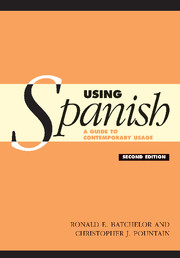Book contents
- Frontmatter
- Contents
- Authors' acknowledgements
- Preface to the second edition
- List of abbreviations and symbols
- Glossary
- The Spanish speaking world: countries where Spanish is spoken, with an estimate of the numbers of native speakers
- 1 Introduction
- 2 Passages illustrating register and local variety
- Part I Vocabulary
- Part II Grammar
- Index
2 - Passages illustrating register and local variety
Published online by Cambridge University Press: 05 June 2012
- Frontmatter
- Contents
- Authors' acknowledgements
- Preface to the second edition
- List of abbreviations and symbols
- Glossary
- The Spanish speaking world: countries where Spanish is spoken, with an estimate of the numbers of native speakers
- 1 Introduction
- 2 Passages illustrating register and local variety
- Part I Vocabulary
- Part II Grammar
- Index
Summary
Example of R1* (Peninsular Spanish): Un encuentro en la calle
Pepe: ¡Eh! ¡macho!
Paco: ¡Joder! No te había visto.
Pepe: ¿Qué hay? ¿Cómo te va?
Paco: Psa, tirando … ¿y tú?
Pepe: Yo, me voy tirao tirao.
Paco: Joder, ya será menos.
Pepe: Quita, tío, quita, que estoy de una mala leche.
Paco: Bueno, a ver qué coño te pasa ahora.
Pepe: Que me se ha escacharrao el coche.
Paco: No, ¿otra vez?
Pepe: Otra vez, joder, otra vez.
Paco: Mucha pasta.
Pepe: Coño, no sé … jo, pero como sea mucha lo tiene claro porque hasta que yo no cobre el mecánico no ve un duro.
Paco: Va, tío, olvídate. Esta noche me voy al cine con unas tías. ¿Te vienes?
Pepe: Hum, no sé. Tengo faena.
Paco: Pero que coño vas a tener tú faena. Pero, macho, de que vas. Si es esta noche.
Pepe: Es que … no sé, joder, no sé.
Paco: Pero coño, tío, si es un rato. No me seas cabrón.
Pepe: Jo, tío, que plomo eres, pero ¿no te he dicho que no lo sé?
Paco: ¿Que tienes plan?
Pepe: Te pego un telefonazo.
Paco: Bueno, bien … Pero … jo, es que esta noche no ceno en casa. Mira, yo te llamo y te digo lo que hay.
Pepe: Hecho.
Paco: Sobre las nueve.
Pepe: Muy bien, tío, nos vemos.
The R1* forms are: the expletives †¡joder! and its shortened form †¡jo! (= damn, lit = fuck) and (qué) †coño (= shit, lit = cunt); the nouns tías (familiarly=girls, though also=whores or prostitutes) and †cabrón (lit=billygoat, but familiarly=bastard), and the expression de una mala leche (=in a foul mood).
Apart from these R1* forms, the conversation has many features which are typical of R1.
- Type
- Chapter
- Information
- Using SpanishA Guide to Contemporary Usage, pp. 4 - 20Publisher: Cambridge University PressPrint publication year: 2005



